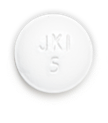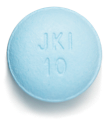
Safety / Side Effects
If you are considering asking your doctor about XELJANZ, it’s important to learn more about the risks and benefits. The tools below can provide helpful information about taking XELJANZ and the safety and side effects of treatment.
The safety information below applies to all marketed formulations of XELJANZ. Specific risks associated with certain dosing are noted.
Possible Side Effects
XELJANZ (tofacitinib) may cause serious side effects.
XELJANZ can lower the ability of your immune system to fight infections. Do not start taking XELJANZ if you have any kind of infection unless your healthcare provider tells you it is okay. Serious infections have happened in people taking XELJANZ. These serious infections include tuberculosis (TB) and infections caused by bacteria, fungi, or viruses that can spread throughout the body. Some people have died from these infections. Your healthcare provider should test you for TB before starting and during treatment with XELJANZ. You should not start taking XELJANZ if you have any kind of infection unless your healthcare professional tells you it is okay.
Before and after starting XELJANZ, tell your doctor if you are being treated for an infection, have infections that keep coming back, or have symptoms of an infection, including:
- fever, sweating, or chills
- cough
- blood in phlegm
- warm, red, or painful skin or sores on your body
- burning when you urinate
- urinating more often than normal
- muscle aches
- shortness of breath
- weight loss
- diarrhea or stomach pain
- feeling very tired
People with ulcerative colitis taking the higher dose of XELJANZ (10 mg twice daily) or XELJANZ XR (22 mg one time each day) have a higher risk of serious infections or shingles.
These are not all of the possible side effects of XELJANZ. Learn more and read the Medication Guide.
Increased risk of death in people 50 years of age and older who have at least 1 heart disease (cardiovascular) risk factor and are taking XELJANZ 5 mg twice daily or XELJANZ 10 mg twice daily.
These are not all of the possible side effects of XELJANZ. Learn more and read the Medication Guide.
XELJANZ may increase your risk of certain cancers by changing the way your immune system works. Lymphoma and other cancers, including skin cancers, can happen. People taking XELJANZ 5 mg twice daily or XELJANZ 10 mg twice daily have a higher risk of certain cancers including lymphoma and lung cancer, especially if you are a current or past smoker. Tell your healthcare provider if you have ever had any type of cancer.
People with ulcerative colitis taking the higher dose of XELJANZ (10 mg twice daily) or XELJANZ XR (22 mg one time each day) have a higher risk of skin cancers.
Some people who have taken XELJANZ with certain other medicines to prevent kidney transplant rejection have had a problem with certain white blood cells growing out of control (Epstein Barr Virus–associated post-transplant lymphoproliferative disorder).
These are not all of the possible side effects of XELJANZ. Learn more and read the Medication Guide.
Increased risk of major cardiovascular events such as heart attack, stroke or death in people 50 years of age and older who have at least 1 heart disease (cardiovascular) risk factor and are taking XELJANZ 5 mg twice daily or XELJANZ 10 mg twice daily, especially if you are a current or past smoker.
Get emergency help right away if you have any symptoms of a heart attack or stroke while taking XELJANZ, including:
- discomfort in the center of your chest that lasts for more than a few minutes, or that goes away and comes back
- severe tightness, pain, pressure, or heaviness in your chest, throat, neck, or jaw
- pain or discomfort in your arms, back, neck, jaw, or stomach
- shortness of breath with or without chest discomfort
- breaking out in a cold sweat
- nausea or vomiting
- feeling lightheaded
- weakness in one part or on one side of your body
- slurred speech
These are not all of the possible side effects of XELJANZ. Learn more and read the Medication Guide.
Blood clots in the lungs (pulmonary embolism, PE), veins of the legs (deep vein thrombosis, DVT), and arteries (arterial thrombosis) have happened more often in people who are 50 years of age and older and with at least 1 heart disease (cardiovascular) risk factor taking XELJANZ 5 mg twice daily or XELJANZ 10 mg twice daily. Blood clots in the lungs have also happened in people with ulcerative colitis. Some people have died from these blood clots.
- Stop taking XELJANZ and tell your healthcare provider right away if you have any signs and symptoms of blood clots such as sudden shortness of breath, difficulty breathing, chest pain, swelling of a leg or arm, leg pain or tenderness, or red or discolored skin in the leg or arm.
These are not all of the possible side effects of XELJANZ. Learn more and read the Medication Guide.
Tell your healthcare provider if you have had diverticulitis (inflammation in parts of the large intestine) or ulcers in your stomach or intestines. Some people taking XELJANZ can get tears in their stomach or intestine. This happens most often in people who also take nonsteroidal anti-inflammatory drugs (NSAIDs), corticosteroids, or methotrexate. Tell your healthcare provider right away if you have fever, stomach-area pain that does not go away, and a change in your bowel habits.
These are not all of the possible side effects of XELJANZ. Learn more and read the Medication Guide.
Serious allergic reactions can occur. Stop using XELJANZ and call your healthcare provider right away if you have swelling of your lips, tongue, throat, or get hives.
These are not all of the possible side effects of XELJANZ. Learn more and read the Medication Guide.
Your doctor should do blood tests to check your white and red blood cells before starting and while you are taking XELJANZ. Your doctor should also check certain liver tests. You should not take XELJANZ if your lymphocyte count, neutrophil count, or red blood cell count is too low or your liver function test levels are too high. Changes in lab test results may cause your healthcare provider to stop your XELJANZ treatment for a time. Your cholesterol levels should be checked 4 to 8 weeks after you start receiving XELJANZ.
These are not all of the possible side effects of XELJANZ. Learn more and read the Medication Guide.
Before you use XELJANZ, tell your healthcare provider if you:
- Are being treated for an infection, have an infection that won’t go away or keeps coming back, or think you have symptoms of an infection
- Have TB, or have been in close contact with someone with TB, or were born in, lived in, or traveled where there is more risk for getting TB
- Have diabetes, chronic lung disease, HIV, or a weak immune system. People with these conditions have a higher chance for infections
- Live or have lived in certain areas (such as Ohio and Mississippi River Valleys and the Southwest) where there is an increased chance for getting certain kinds of fungal infections
- Have or have had Hepatitis B or C
- Are a current or past smoker
- Have had any type of cancer
- Have had a heart attack, other heart problems or stroke
- Have had blood clots
- Have liver or kidney problems
- Have any stomach area (abdominal) pain or been diagnosed with diverticulitis or ulcers in your stomach or intestines
- Have recently received or plan to receive a vaccine. People taking XELJANZ should not receive live vaccines but can receive non-live vaccines
- Are pregnant, planning to become pregnant, breastfeeding, or planning to breastfeed. You should not take XELJANZ and breastfeed
- Have had a reaction to tofacitinib or any of the ingredients
- Are taking other medicines, including prescription and over-the-counter medicines, vitamins, and herbal supplements. Especially tell your healthcare provider if you take any of the following medicines while taking XELJANZ since this may increase your risk of infection:
- tocilizumab (Actemra®)
- etanercept (Enbrel®)
- adalimumab (Humira®)
- infliximab (Remicade®)
- rituximab (Rituxan®)
- abatacept (Orencia®)
- anakinra (Kineret®)
- certolizumab (Cimzia®)
- golimumab (Simponi®)
- ustekinumab (Stelara®)
- secukinumab (Cosentyx®)
- vedolizumab (Entyvio®)
- ixekizumab (Taltz®)
- sarilumab (Kevzara®)
- azathioprine, cyclosporine, or other immunosuppressive drugs
- Tell your healthcare provider if you are taking medicines that affect the way certain liver enzymes work. Ask your healthcare provider if you are not sure if your medicine is one of these.
These are not all of the possible side effects of XELJANZ. Learn more and read the Medication Guide.
If you are a carrier of the Hepatitis B or C virus (viruses that affect the liver), the virus may become active while you use XELJANZ. Your healthcare provider may do blood tests before starting and while using treatment with XELJANZ. Tell your healthcare provider if you have any signs of these symptoms: feel very tired, little or no appetite, clay-colored bowel movements, chills, muscle aches, skin rash, skin or eyes look yellow, vomiting, fevers, stomach discomfort, or dark urine.
Common side effects in people with rheumatoid arthritis, psoriatic arthritis, and ankylosing spondylitis include upper respiratory tract infections (common cold, sinus infections), headache, diarrhea, nasal congestion, sore throat, runny nose (nasopharyngitis), high blood pressure (hypertension), and acne.
Common side effects in people with ulcerative colitis include nasal congestion, sore throat, runny nose (nasopharyngitis), increased cholesterol levels, headache, upper respiratory tract infections (common cold, sinus infections), increased muscle enzyme levels, rash, acne, diarrhea, and shingles (herpes zoster).
Common side effects in children (2 & older) with polyarticular course juvenile arthritis include upper respiratory tract infections (common cold, sinus infections), nasal congestion, sore throat, and runny nose (nasopharyngitis), headache, fever, nausea, vomiting, and acne.
These are not all of the possible side effects of XELJANZ. Learn more and read the Medication Guide.
Patients should always ask their doctors for medical advice about adverse events. You are encouraged to report adverse events related to Pfizer products by calling 1-800-438-1985 (U.S. only). If you prefer, you may contact the U.S. Food and Drug Administration (FDA) directly. Visit www.fda.gov/MedWatch or call 1-800-FDA-1088.

Questions About XELJANZ
XELJANZ can lower the ability of your immune system to fight infections. Do not start taking XELJANZ if you have any kind of infection unless your healthcare provider tells you it is okay. Serious infections have happened in people taking XELJANZ. These serious infections include tuberculosis (TB) and infections caused by bacteria, fungi, or viruses that can spread throughout the body. Some people have died from these infections. Your healthcare provider should test you for TB before starting and during treatment with XELJANZ. You should not start taking XELJANZ if you have any kind of infection unless your healthcare professional tells you it is okay.
People with ulcerative colitis taking the higher dose of XELJANZ (10 mg twice daily) or XELJANZ XR (22 mg one time each day) have a higher risk of serious infections, shingles, or skin cancers.
Take XELJANZ/XELJANZ XR/XELJANZ Oral Solution exactly as your healthcare provider tells you to take it.
Take XELJANZ/XELJANZ Oral Solution 2 times a day with or without food.
Take XELJANZ XR 1 time a day with or without food.
Swallow XELJANZ XR tablets whole and intact. Do not crush, split, or chew.
When you take XELJANZ XR, you may see something in your stool that looks like a tablet. This is the empty shell from the tablet after the medicine has been absorbed by your body.
If you take too much XELJANZ/XELJANZ XR/XELJANZ Oral Solution, call your healthcare provider or go to the nearest hospital emergency room right away.
For the treatment of psoriatic arthritis, take XELJANZ/XELJANZ XR in combination with methotrexate, sulfasalazine or leflunomide as instructed by your healthcare provider.
XELJANZ XR should not be used instead of XELJANZ Oral Solution.
Taking XELJANZ/XELJANZ XR
Depending on your diagnosis and other factors, your doctor may prescribe you a different dosage of XELJANZ or XELJANZ XR—which affects how many times a day you take your medication. In the meantime, learn more about the options you may have by selecting your condition.
XELJANZ XR should not be used instead of XELJANZ Oral Solution.
What are my options?
How It’s Taken
Twice a day with or without food
How It’s Delivered
Immediate release into the bloodstream over the course of several hours

How It’s Taken
Once a day with or without food*
How It’s Delivered
Extended release into the bloodstream over the course of a day

*XELJANZ XR tablets should be swallowed whole and intact. Do not crush, split, or chew.
Note: Pills not actual size
What are my options?
How It’s Taken
Twice a day with or without food
How It’s Delivered
Immediate release into the bloodstream over the course of several hours

How It’s Taken
Once a day with or without food†
How It’s Delivered
Extended release into the bloodstream over the course of a day

*For active psoriatic arthritis (PsA), XELJANZ and XELJANZ XR should be taken with a disease-modifying antirheumatic drug (DMARD) such as methotrexate.
†XELJANZ XR tablets should be swallowed whole and intact. Do not crush, split, or chew.
Note: Pills not actual size
What are my options?
How It’s Taken
Twice a day with or without food
How It’s Delivered
Immediate release into the bloodstream over the course of several hours

How It’s Taken
Twice a day with or without food
How It’s Delivered
Immediate release into the bloodstream over the course of several hours

How It’s Taken
Once a day with or without food†
How It’s Delivered
Extended release into the bloodstream over the course of a day

How It’s Taken
Once a day with or without food†
How It’s Delivered
Extended release into the bloodstream over the course of a day

*For moderate to severe UC, the recommended starting dose of XELJANZ/XELJANZ XR is 10 mg twice daily or 22 mg once daily for 8 weeks. Depending on your doctor’s assessment of your progress, your maintenance dose may be 5 mg or 10 mg twice daily, or 11 mg or 22 mg once a day if you are taking XELJANZ XR. You should use the lowest effective dose to maintain response. Therapy should be discontinued after 16 weeks of 22 mg once daily or 10 mg twice daily if adequate symptom improvement is not achieved.
†XELJANZ XR tablets should be swallowed whole and intact. Do not crush, split, or chew.
Note: Pills not actual size